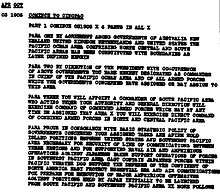Pacific Ocean Areas (command)
Pacific Ocean Areas was a major Allied military command in the Pacific Ocean theater of World War II. It was one of four major Allied commands during the Pacific War, and one of three United States commands in the Asiatic-Pacific Theater. Admiral Chester W. Nimitz of the U.S. Navy headed the command throughout its existence.
The vast majority of Allied forces in the theatre were from the U.S. Navy, U.S. Army and U.S. Marine Corps. However units and/or personnel from New Zealand, the United Kingdom, Australia, Canada, Mexico, Fiji and other countries also saw active service.
Formation and composition

On 24 March 1942, the newly formed British and US Combined Chiefs of Staff issued a directive designating the Pacific theater an area of American strategic responsibility. On 30 March the US Joint Chiefs of Staff (JCS) divided the Pacific theater into three areas: the Pacific Ocean Areas (POA), the South West Pacific Area (SWPA), and the Southeast Pacific Area.[1][2][3] Details and transition, including whether Nimitz "appointed" or "nominated" the commander of the South Pacific Area, were worked out between 3 April and formal assumption of the overall Commander-in-Chief Pacific Ocean Areas by Nimitz on 8 May 1942.[4][5]
The JCS designated Admiral Chester W. Nimitz as Commander in Chief, Pacific Ocean Areas (CINCPOA), with operational control over all units (air, land, and sea) in that area. The theater included most of the Pacific Ocean and its islands, but mainland Asia was excluded from the POA, as were the Philippines, Australia, the Netherlands East Indies, the Territory of New Guinea (including the Bismarck Archipelago) and the western part of the Solomon Islands. US strategic bomber forces in the theatre were under the direct control of the US Joint Chiefs of Staff. All land forces in Alaska and Canada remained under the control of the US Army's Western Defense Command (see Aleutian Islands Campaign).
The Joint Chiefs further divided the Pacific Ocean Areas into the North, Central and South Pacific Areas. Nimitz designated subordinate commanders for the North and South Pacific Areas (NORPAC and SOPAC) but retained the Central Pacific Area (CENPAC), including the Hawaiian Department, under his direct command.
From 1942-1943, three Army infantry divisions (23rd/"Americal", 25th, 27th) and two Marine divisions (1st, 2nd) fought in the POA (the 1st and 3rd Marine Divisions also fought in the SWPA in 1943). From 1944-1945, five Army infantry divisions (7th, 27th, 77th, 81st, 96th) and six Marine divisions (1st, 2nd, 3rd, 4th, 5th, 6th) served in the POA (an additional 15 Army divisions fought in the SWPA during this time).[6] Among allied land force formations was the 3rd New Zealand Division, which fought in the Solomon Islands campaign during 1943-44.
U.S. Army Air Forces (USAAF) operated in the POA under the Seventh, Thirteenth, and Twentieth Air Forces at various times. Allied air forces included units of the Royal New Zealand Air Force.
In the separate South West Pacific Area, General Douglas MacArthur assumed command. The effective result of this organizational scheme was the creation of two separate commands in the Pacific: POA and SWPA, each reporting separately to the Joint Chiefs, each competing for scarce resources in an economy-of-force theater, and each headed by a commander in chief (CINC) from a different service. In particular, the division of the Solomons caused problems, since the battles of the Solomon Islands campaign in 1942–1943 ranged over the whole region, with the main Japanese bases in SWPA and the main Allied bases in SOPAC.
Commanders
Commanders, South Pacific Area
- Vice Admiral Robert L. Ghormley (19 June–18 October 1942)
- Vice Adm./Adm. William Halsey, Jr. (18 October 1942 – 15 June 1944)
- Vice Adm. John H. Newton (15 June 1944 – 13 March 1945)
- Vice Admiral William L. Calhoun (13 March–2 September 1945)
Commanders, North Pacific Area
- Rear Adm. Robert A. Theobald (17 May 1942 – 4 January 1943)
- Rear Adm. Thomas C. Kinkaid (4 January–11 October 1943)
- Vice Adm. Frank J. Fletcher (11 October 1943 – 2 September 1945)
See also
Notes
- ↑ Cressman 1999, p. April 3, Fri. entry.
- ↑ Potter 1967, p. 45.
- ↑ Williams 1960, pp. 30—31.
- ↑ Morton 2000, pp. 244—256.
- ↑ Nimitz 1942, p. Entries April 1942.
- ↑ Mark R. Henry and Mike Chappell, The U.S. Army of World War II, Volume 1: The Pacific (Men at Arms Series, 342)(Osprey Publishing: 2000)
References
- Cressman, Robert J. (1999). "The Official Chronology of the U.S. Navy in World War II". Contemporary History Branch, Naval Historical Center (now Naval History & Heritage Command). Retrieved 24 May 2013.
- Morton, Louis (2000). The War in the Pacific—Strategy and Command: The First Two Years. United States Army In World War II. Washington, D. C.: Center Of Military History, United States Army. LCCN 61-60001.
- Nimitz, Chester W., Admiral (USN); Steele, James M., Captain (USN) (1942). ‘Gray Book’ — War Plans and Files of the Commander-in-Chief, Pacific Fleet; Running Estimate and Summary maintained by Captain James M. Steele, USN, CINCPAC staff at Pearl Harbor, Hawaii, covering the period 7 December 1941–31 August 1942. (PDF). 1 of 8 volumes. Operational Archives, Naval History and Heritage Command, Washington Navy Yard, Washington D.C. Retrieved 24 May 2013.
- Potter, E.B. (1976). Nimitz. Annapolis, Md.: Naval Institute Press. ISBN 978-0-87021-492-9. LCCN 76-1056.
- Williams, Mary H. (1960). Chronology 1941—1945. United States Army In World War II. Washington, DC: Center Of Military History, United States Army. LCCN 59-60002.
- Willmott, H. P. (1983). The Barrier and the Javelin: Japanese and Allied Pacific Strategies February to June 1942. Annapolis, Maryland: Naval Institute Press. ISBN 0-87021-535-3.
External links
- Central Pacific 1941–1943. The U.S. Army Campaigns of World War II. United States Army Center of Military History. CMH Pub 72-4.
- Strategy and Command: The First Two Years
- The Official Chronology of the U.S. Navy in World War II, Appendix I